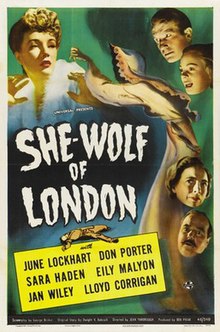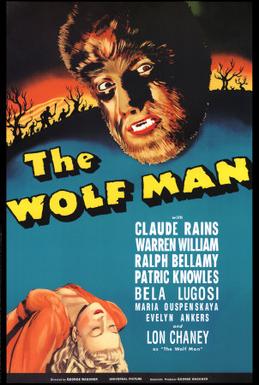
The Wolf Man is a 1941 American horror film written by Curt Siodmak and produced and directed by George Waggner. The film stars Lon Chaney Jr. in the title role. Claude Rains, Warren William, Ralph Bellamy, Patric Knowles, Bela Lugosi, Evelyn Ankers, and Maria Ouspenskaya star in supporting roles. The title character has had a great deal of influence on Hollywood's depictions of the legend of the werewolf. The film is the second Universal Pictures werewolf film, preceded six years earlier by the less commercially successful Werewolf of London (1935). This film is part of the Universal Monsters movies and is of great cinematic acclaim for its production.
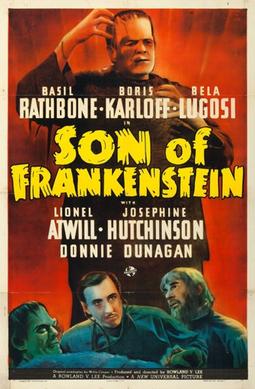
Son of Frankenstein is a 1939 American horror film that was directed by Rowland V. Lee and stars Basil Rathbone, Boris Karloff and Bela Lugosi. The film is the third in Universal Pictures' Frankenstein series and is the follow-up to the 1935 film Bride of Frankenstein. Son of Frankenstein stars Rathbone as Baron Wolf von Frankenstein who, with his wife Elsa and son Peter, returns to his late father's estate. Near the castle lives Ygor, a crazed blacksmith whose neck was broken in an unsuccessful hanging attempt. Among the castle's remains, Frankenstein discovers the remains of the monster and decides to try to save his family name by resurrecting the creature to prove his father was correct. He finds, however, the monster only responds to Ygor's commands.

The Black Cat is a 1941 American comedy horror and mystery film directed by Albert S. Rogell and starring Basil Rathbone. The film was a hybrid of style: being inspired by comedy "Old Dark House" films of the era as well as the 1843 short story "The Black Cat" by Edgar Allan Poe. It stars Basil Rathbone as Montague Hartley, the head of a greedy family who await the death of Henrietta Winslow so that they can inherit her fortune. When she is found murdered, an investigation begins into who might be the culprit. Alongside Rathbone and Loftus, the film's cast includes Hugh Herbert, Broderick Crawford, and Bela Lugosi.

Frankenstein Meets the Wolf Man is a 1943 American horror film directed by Roy William Neill and starring Lon Chaney Jr. as the Wolf Man and Bela Lugosi as Frankenstein's monster. This was the first of a series of later called "monster rallies" combining characters from several film series. This film's script written by Curt Siodmak follows The Ghost of Frankenstein and The Wolf Man. The film involves Larry Talbot who is brought back to life. Seeking a way to return to his death to escape his werewolf curse, he meets with gypsy Maleva who advises him that the only way to stay dead is to confer with Dr. Frankenstein. The doctor is long dead but his equipment is in working condition, leading Talbot to seek the help of scientist Dr. Mannering and Frankenstein descendant Baroness Elsa Frankenstein. Talbot then attempts to have his life sucked from his body and transferred into Frankenstein's monster.

House of Frankenstein is a 1944 American horror film starring Boris Karloff, Lon Chaney Jr. and John Carradine. Based on a story by Curt Siodmak, it was directed by Erle C. Kenton and produced by Universal Pictures. The film is about Dr. Gustav Niemann, who escapes from prison and promises to create a new body for his assistant Daniel. Over the course of the film, they encounter Count Dracula, Larry Talbot, the Wolf Man, and Frankenstein's Monster.

House of Dracula is a 1945 American horror film released and distributed by Universal Pictures. Directed by Erle C. Kenton, the film features several Universal Horror properties meeting as they had done in the 1944 film House of Frankenstein. The film is set at the castle home of Dr. Franz Edelmann, who is visited first by Count Dracula and later by Larry Talbot, the Wolf Man, who are trying to cure their vampirism and lycanthropy, respectively. Talbot is eventually cured, which leads him to discover the body of Frankenstein's monster in a cave below the base of the castle. Edelemann takes the monster's body back to his laboratory but finds Count Dracula has awakened and by attacking his assistants, he captures Edelmann and forces a reverse blood transfusion, which gives Edelmann a split personality and makes him a killer.

The Mummy's Tomb is a 1942 American horror film directed by Harold Young and starring Lon Chaney Jr. as Kharis the mummy. Taking place 30 years after the events of The Mummy's Hand, where Andoheb has survived and plans revenge on Stephen Banning and his entire family in Mapleton, Massachusetts. With the help of the high priest Mehemet Bey, Andoheb and the mummy Kharis Bey takes up a job as a caretaker of a graveyard. At the first full moon, the mummy is fed tanna leaves which allow him to break into the Banning residence and kill the now elderly Stephen. Banning's son then seeks assistance from Babe Hanson, one of the members of the original Banning expedition to Egypt to stop Andoheb and Kharis.
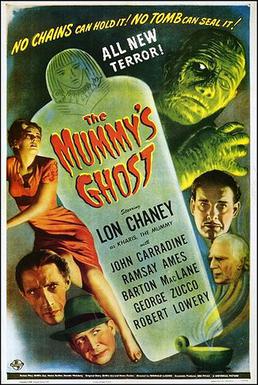
The Mummy's Ghost is a 1944 American horror film directed by Reginald Le Borg for Universal. It is the second of three sequels to The Mummy's Hand (1940), following The Mummy's Tomb (1942) and preceding The Mummy's Curse (1944). Lon Chaney Jr. again takes on the role of Kharis the mummy.

Werewolf of London is a 1935 horror film directed by Stuart Walker and starring Henry Hull as the titular werewolf. The supporting cast includes Warner Oland, Valerie Hobson, Lester Matthews, and Spring Byington. Jack Pierce, who is best known for creating the iconic makeup worn by Boris Karloff in the 1931 film Frankenstein, created the film's werewolf makeup. Produced by Universal Pictures, Werewolf of London was the first feature-length werewolf film.
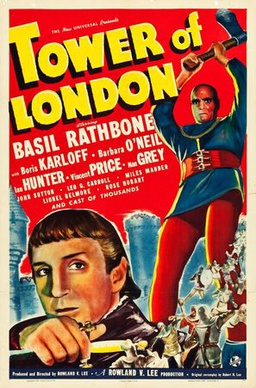
Tower of London is a 1939 black-and-white historical film directed and produced by Rowland V. Lee. It stars Basil Rathbone as the future King Richard III of England, and Boris Karloff as his fictitious club-footed executioner Mord. The film is based on the traditional depiction of Richard rising to become King of England in 1483 by eliminating everyone ahead of him. Each time Richard accomplishes a murder, he removes one figurine from a dollhouse resembling a throneroom. Once he has completed his task, he now needs to defeat the exiled Henry Tudor to retain the throne.
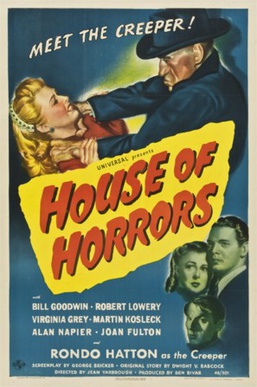
House of Horrors is a 1946 American horror film released by Universal Pictures, starring Rondo Hatton as a madman named "the Creeper".

Universal Classic Monsters is a home video line based on a series of horror films primarily produced by Universal Pictures from the 1930s to the 1950s. Although not initially conceived as a franchise, the enduring popularity and legacy of the films and the characters featured in them has led the studio to market them under the collective brand name of Universal Studios Monsters. Steve Jones of USA Today described Universal's most famous monsters as "pop culture icons", specifically Dracula, Frankenstein, the Mummy, and the Wolf Man.

Captive Wild Woman is a 1943 American horror film directed by Edward Dmytryk. The film stars Evelyn Ankers, John Carradine, Milburn Stone, and features Acquanetta as Paula, the Ape Woman. The film involves a scientist, Dr. Sigmund Walters, whose experiments turn a female gorilla named Cheela into a human by injecting the ape with sex hormones and via brain transplants.
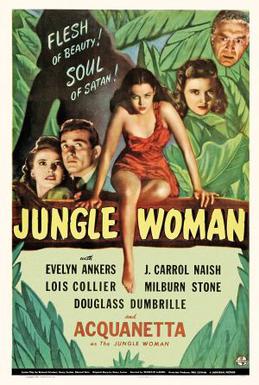
Jungle Woman is a 1944 American horror film directed by Reginald LeBorg. The film stars Evelyn Ankers, J. Carrol Naish, Samuel S. Hinds, Lois Collier, Milburn Stone, and Douglass Dumbrille. The film involves Dr. Carl Fletcher who is in court on the murder of Paula Dupree, who he explains has the ability to turn into an Ape Woman.
Shock Theater is a package of 52 pre-1948 classic horror films from Universal Studios released for television syndication in October 1957 by Screen Gems, the television subsidiary of Columbia Pictures. The Shock Theater package included Dracula, Frankenstein, The Mummy, The Invisible Man and The Wolf Man as well as a few non-horror spy and mystery films. A second package, Son of Shock, was released for television by Screen Gems in 1958, with 20 horror films from both Universal and Columbia.
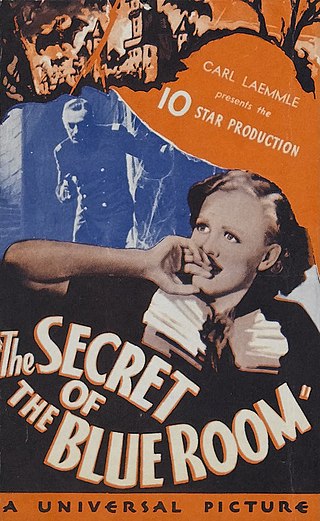
The Secret of the Blue Room is a 1933 American pre-Code mystery horror film directed by Kurt Neumann and starring Lionel Atwill, Gloria Stuart, Paul Lukas, and Edward Arnold. A remake of the German film Geheimnis des blauen Zimmers (1932), it concerns a group of wealthy people who stay at a European mansion that features a blue room that is said to be cursed, as everyone who has stayed there has died shortly after. Three people suggest a wager that each can survive a night in the blue room.

The Cat Creeps is a 1946 American film directed by Erle C. Kenton and starring Noah Beery, Jr., Lois Collier, and Paul Kelly. It follows a journalist and his photographer who attempt to research an unsolved death and locate a missing fortune, with the help of a black cat that appears to be possessed by the spirit of a dead woman.

Jan Wiley was an American film actress.

Frankenstein is a film series of horror films from Universal Pictures based on the play version by Peggy Webling and the 1818 novel Frankenstein; or, The Modern Prometheus by Mary Shelley. The series follow the story of a monster created by Henry Frankenstein who is made from body parts of corpses and brought back to life. The rest of the series generally follows the monster continuously being revived and eventually focuses on a series of cross overs with other Universal horror film characters such as The Wolf Man. The series consists of the following films: Frankenstein (1931), Bride of Frankenstein (1935), Son of Frankenstein (1939), The Ghost of Frankenstein (1942), Frankenstein Meets the Wolf Man (1943), House of Frankenstein (1944), House of Dracula (1945) and Abbott and Costello Meet Frankenstein (1948).
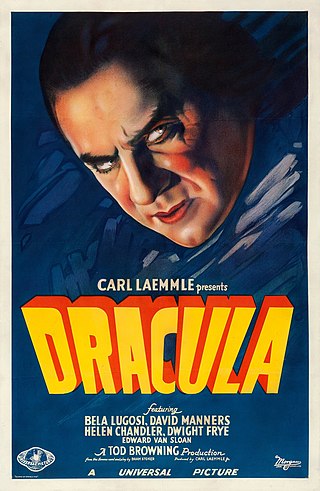
Dracula is a film series of horror films from Universal Pictures based on the 1897 novel Dracula by Bram Stoker and its 1927 play adaptation. The series is a loose collection of films, with historians stating that the films all reference characters, events or at least passing knowledge of the 1931 English-language production of Dracula, with historians noting that Dracula's Daughter and Son of Dracula are more closely related to the 1931 film while the character of Dracula would make smaller appearances in later films such as House of Frankenstein and House of Dracula. After Dracula's Daughter, the character of Dracula and other vampires in the series became more Americanized starting with the release of Son of Dracula, and the later House of films. The character of Dracula appears in all the films outside of Dracula's Daughter, where he is portrayed by Bela Lugosi, Lon Chaney Jr., and John Carradine in the House of films.
